How Many Types Of Animals Are Used During Animal Testing
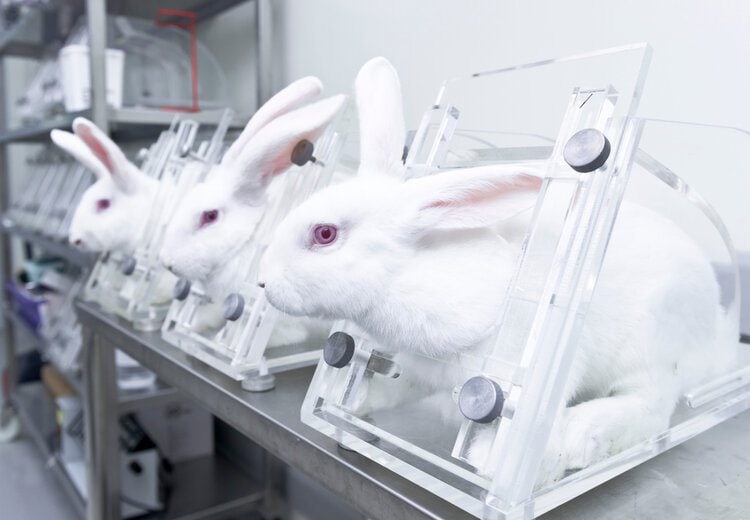
Note: This article's statistics come from third-political party sources and do not represent the opinions of this website.
For decades, animals have been used in testing and research across a variety of industries. From cosmetics development to the study of man drugs and diseases, experiments on animals are a part of them all. Some believe brute testing is the best way to keep humans safe and accelerate medical discovery. Others are horrified that such research comes at the price of fauna suffering and death. Whatever side of the argue you lot fall on (or if y'all're neutral on the subject), here are twenty fauna testing statistics you need to know including:
- The Number of Animals Used In Testing
- What Animals Are Used For Which Testing And Where
- The Ethical Dilemmas And The Future of Animal Testing

20 Animate being Testing Statistics
- An estimated 100 million animals are used in experiments each yr in the United states.
- The UK conducted 2.9 million experiments involving animals in 2020.
- The virtually reliable worldwide count from 2015 estimated that at least 192.1 million animals are being used for scientific enquiry worldwide.
- 3 million experiments on animals were performed in the European Union in 2018.
- Mice were the primary species used in European union scientific research in 2018, making upwards 52.1% of the total animals.
- The United states conducts 53% of research on rabbits, hamsters, and guinea pigs.
- Birds, fish, and rodents brand upward 96% of beast research subjects in the Britain.
- In the UK, 54% of animal testing experiments are conducted by universities.
- Massachusetts has the highest number of (protected) inquiry animals of any U.s. state, 84,798 total in 2019.
- The National Institute of Wellness (NIH) owns over 7,000 monkeys used for inquiry.
- Over lxx% of research monkeys used in the US are imported from Red china.
- The NIH spends an estimated 14.v billion taxpayer dollars on creature testing each year.
- Between 85%-95% of inquiry animals are not protected past law.
- Merely 8% of drugs tested on animals are eventually approved for human being use.
- 21% of countries in the world—41 in total—accept full or fractional bans on corrective testing in animals.
- 56% of Americans believe using animals for scientific inquiry is "morally adequate."
- 68% of people surveyed in the United kingdom want all animal testing to end.
- 34% of research animals in the Usa were involved in painful experiments.
- There are almost 50 available non-creature research tests, with more in development.
- The Ecology Protection Bureau (EPA) plans to decrease creature experiments by 30% by 2025.
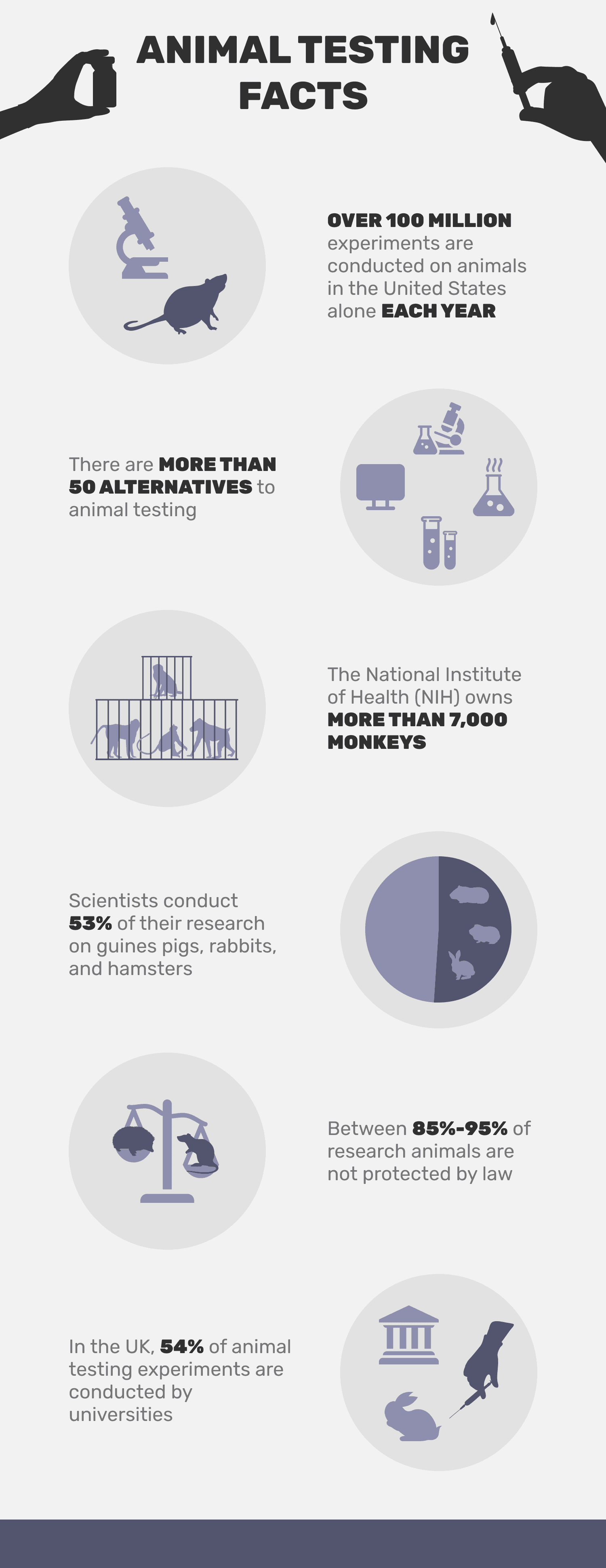

The Number of Animals Used In Testing
1. An estimated 100 one thousand thousand animals are used for experiments each year in the The states. (HSUS)
Unfortunately, there's no reliable style to determine exactly how many animals are used for testing in the The states. The U.Southward. Department of Agriculture (USDA) only maintains a count of research animals protected past the Animal Welfare Human action (AWA.) Rats, mice, and birds are not protected, despite being the nearly common species used for testing.
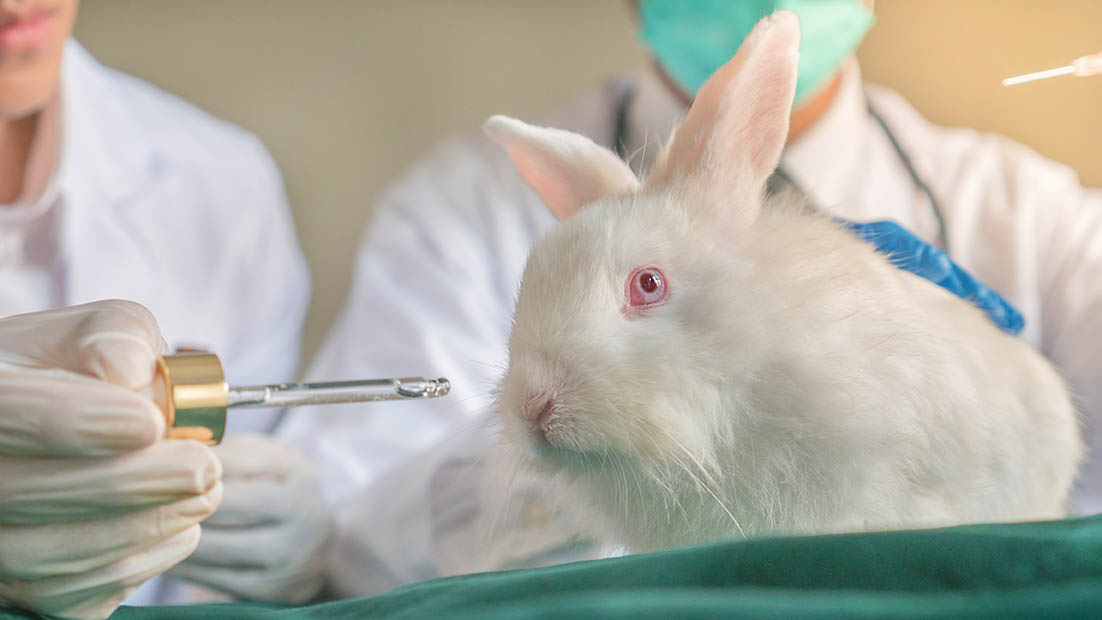
ii. The UK performed 2.9 meg experiments involving animals in 2020. (Cruelty-Free)
Near half of these procedures involved breeding genetically-altered animals, while the other half were experiments performed on animals. Twenty-eight percent of these experiments caused moderate to severe suffering.
3. The most reliable worldwide count, conducted in 2015, estimated that at least 192.ane 1000000 animals are used for testing and enquiry globally. (Cruelty-Free)
Global figures are extremely difficult to rails with accuracy considering every country classifies research animals differently and not all share their information. The top three countries for brute testing are the U.s., China, and Japan.
4. 12.3 one thousand thousand experiments on animals were performed in the EU in 2018. (Cruelty-Free)
These figures—the latest available—still include numbers from the Britain, which conducted the highest number of tests. Germany and French republic were next in line. These iii countries were responsible for more than than half of the animal testing in the European union.
What Animals Are Used For Which Testing And Where
five. Mice made up 52.1% of the total animals used in research in the EU in 2018, the most of any species. (Speaking Of Research EU)
Later mice, the next well-nigh used species were fish at 26.ii% and rats at 9.5%. Cats, dogs, and not-human being primates (monkeys) fabricated upward only 0.three% of all tests conducted.

six. The US conducts 53% of research on rabbits, hamsters, and republic of guinea pigs.(Speaking of Research The states)
Unlike the EU, the US does not maintain stats on all species used, only those protected by the Creature Welfare Deed, which does not include mice, fish, or rats. This makes it hard to produce authentic numbers on all animals used in testing. From the available numbers, we know the U.s.a. tests more on dogs and cats (x%) and monkeys (9%) than the Eu.
7. Birds, fish, and rodents make up 96% of research subjects in the UK. (Speaking of Research U.s.a.)
Different the Usa, the UK does include these species in its statistics. From this data, we meet that the Uk conducts the vast majority of its testing on mice, rats, fish, and birds.
8. In the Britain, 54% of experiments were conducted by universities in 2020. (Great britain Gov)
In addition, 27% of experiments were carried out by commercial laboratories. This was an increase of five% over the number of procedures performed in 2019. Academy enquiry is generally carried out using taxpayer coin.
ix. Massachusetts has the highest number of (protected) research animals of any Usa state, 84,798 total in 2019. (USDA)
The top 3 species used in experiments in this state are republic of guinea pigs (22,876), rabbits (17,581), and non-human being primates (sixteen,573). Kansas and California are the next highest states for animal testing. The full protected species used beyond the US in 2019 was 797,546.
10. The NIH owns over 7,000 monkeys used for enquiry. (Science)
The NIH (National Institute of Health) uses monkeys primarily for medical research. In a 2020 spending beak, Congress instructed the NIH and other government institutions to develop plans to reduce the use of monkeys in testing.
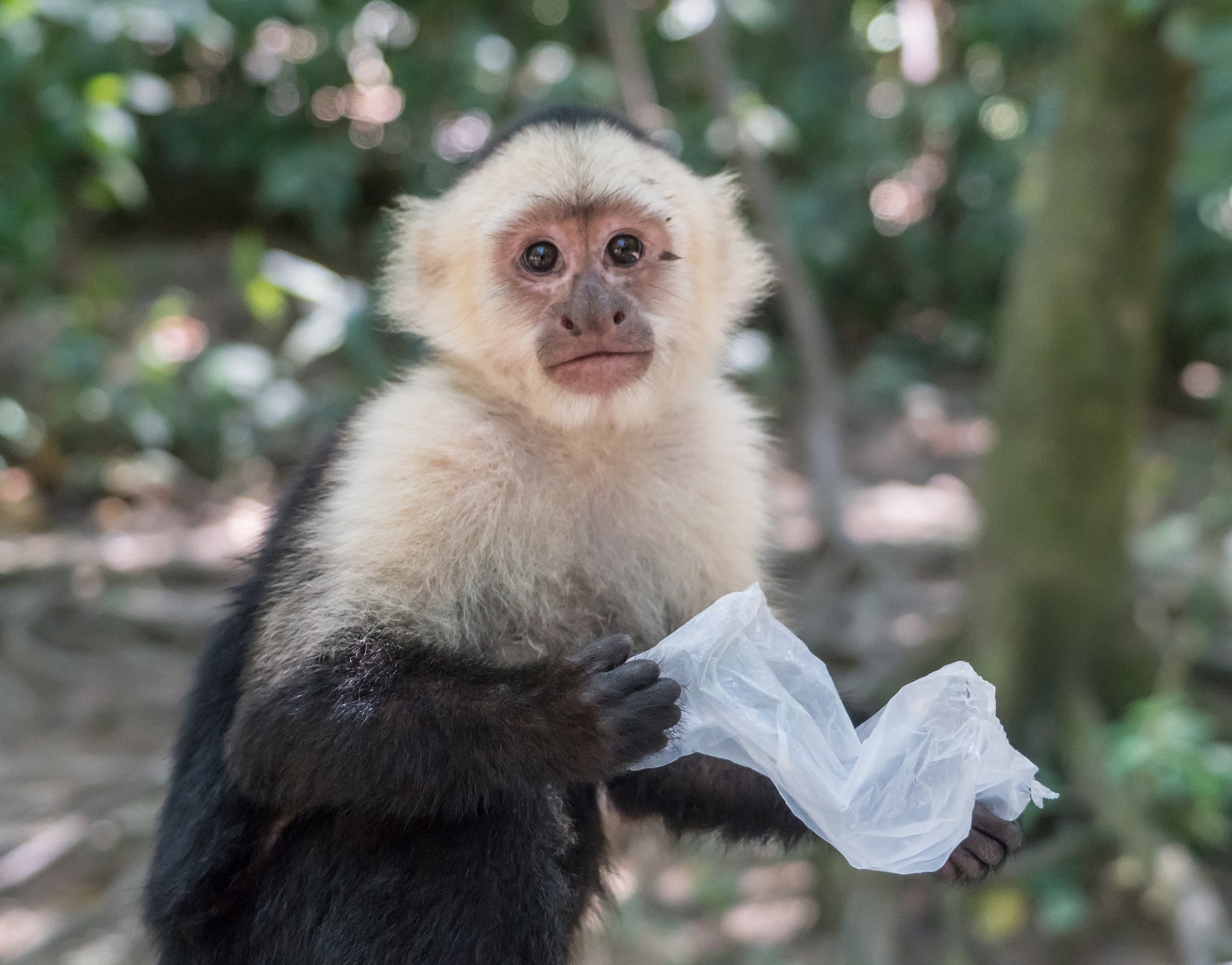
11. Over seventy% of research monkeys used in the Us are imported from China. (Wiley)
China's monkey stock is the production of breeding operations, most of which rely on animals imported from outside the country. Currently, China is facing a shortage of research monkeys due to the Covid-19 pandemic and restrictions on imports and export.
12. The NIH spends an estimated 14.five billion taxpayer dollars on fauna testing each twelvemonth. (ALDF)
This number doesn't include the money spent past other government organizations like the FDA or private organizations. Recent U.s.a. budgets have proposed an increase in funding for the NIH, particularly in breeding programs to address the shortage of research monkeys.
thirteen. Between 85%-95% of research animals are non protected past law in the United States. (ALDF)
We already mentioned that the Animate being Welfare Act excludes the majority of animals used for research in the United States. The animals not protected are non counted in national statistics and no one knows how many there are or what kind of experiments they are used in. Using these animals also exempts enquiry facilities from any requirement to find alternative testing methods.
The Ethical Dilemmas And The Futurity of Animal Testing
14. Simply eight% of drugs tested on animals are eventually approved for human use. (ALDF)
Critics of animal testing bespeak to this statistic when arguing that the practice offers minimal reward for the money spent and pain inflicted on research animals. This fuels the call for a move away from animal testing in favor of more effective newer technologies.

xv. 21% of countries worldwide—41 in total—have total or partial bans on animal cosmetic testing. (HSUS)
The EU banned corrective testing in 2013. In the United States, merely eight states accept banned corrective testing on animals. Unlike China, which historically has required all cosmetics to first be tested on animals, the US Food and Drug Assistants has no beast testing requirement for cosmetics.
sixteen. 56% of Americans believe using animals for medical inquiry is "morally adequate." (Gallup)
Based on a poll conducted in May 2020, this number represents a decrease over well-nigh xx years, with 65% of Americans in 2001 believing it was morally acceptable. Yet, the 2019 poll constitute 51% of Americans support animal employ in medical research, so the number appears to be rising again.
17. 68% of people surveyed in the UK desire all animal testing to finish.
(AnimalFreeResearchUK)
Based on a poll conducted in 2021, this data shows that creature testing is unpopular in the UK. The same survey found that 70% of UK residents support phasing out medical testing by 2040. Support was also high (60%) for government investment in beast testing alternatives.
18. 34% of research animals in the Usa were involved in painful experiments in 2019.
(Speaking of Inquiry U.s.a.)
Again, these figures but apply to animals covered under the AWA. Mice, rats, fish, and birds are left out. Twenty-8 percentage of painful experiments allowed or required anesthesia, while 6% did not due to concern over the impact on the results.
19. At that place are near 50 non-fauna research alternatives available, with more in development.
(AltTox)
With improvements in technology, the alternatives to animal testing continue to grow. Animal testing alternatives are often more toll-effective and lack ethical and moral dilemmas.
twenty. The Environmental Protection Agency (EPA) plans to decrease testing on mammals by 30% by 2025. (EPA)
The agency besides plans to phase out all testing on mammals past 2035, with rare exceptions. The EPA has been moving to switch to non-brute testing wherever they can over the past several years. An estimated 200,000 lab animals have already been saved thanks to their efforts.

Ofttimes Asked Questions About Animal Testing
What Protections Exist For Research Animals In The United States?
The Animal Welfare Deed, which became law in 1966, established bones standards for housing, nutrition, veterinary care, and humane treatment for research animals. However, equally we mentioned earlier, the act only covers sure mammal species and completely excludes mice, rats, invertebrates, reptiles, fish, and birds.
Another policy, the Public Health Service Policy on Humane Use of Laboratory Animals covers more species only generally merely applies to university labs. Research facilities too must found an animal care committee to review all proposed animal experiments. Labs are also discipline to state and local regulations, and many states have stronger animal welfare laws. (NCBI)
What Blazon Of Testing Is Performed On Animals?
Inquiry animals are subjected to many different types of procedures. Many are deliberately exposed to chemicals and drugs. Others are intentionally burned and wounded to study healing or subjected to surgical procedures. Procedures may also involve pain, genetic manipulation, and distressing behavioral experiments. (HSI)
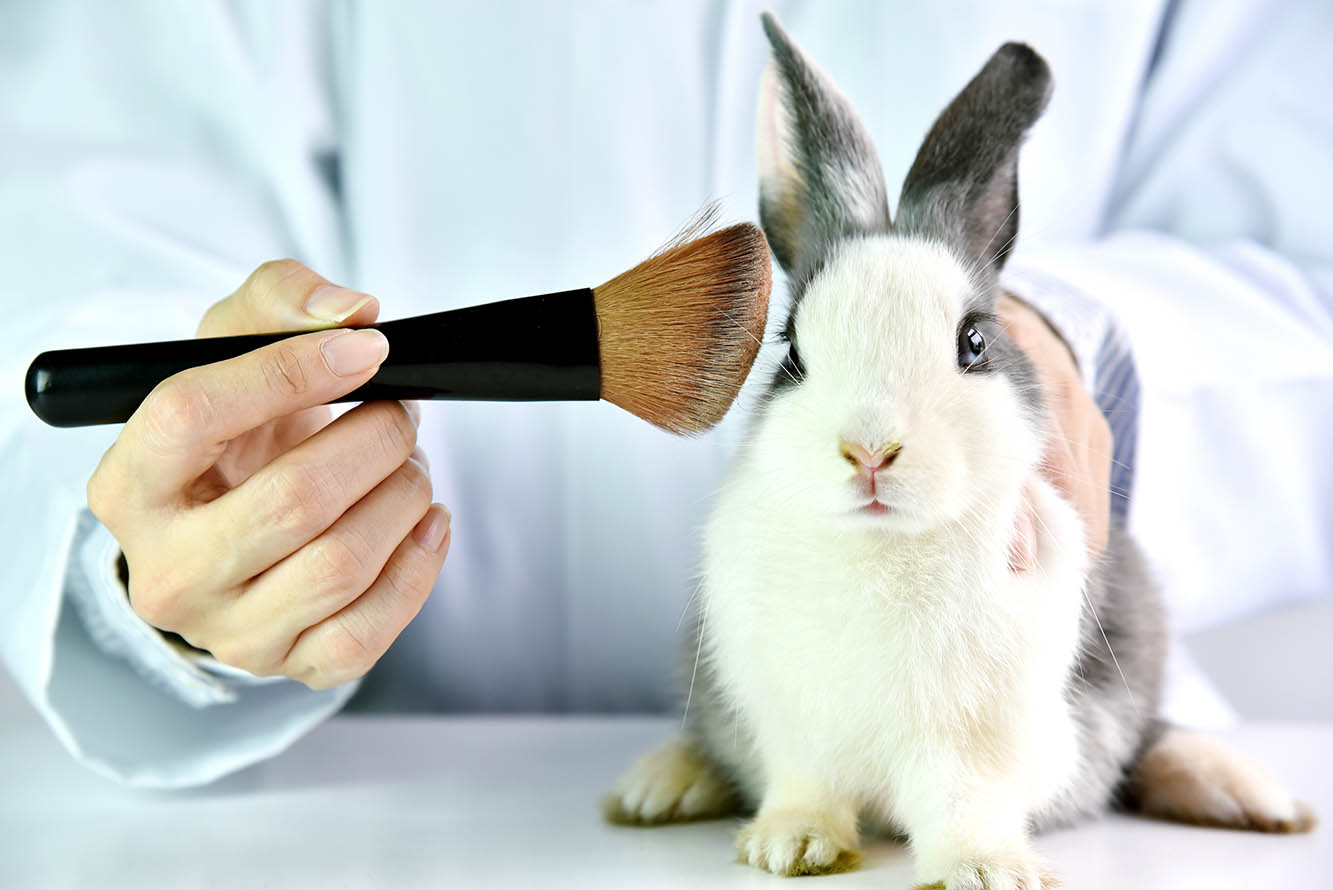
Practice Animals Ever Survive The Testing?
It's estimated that only nearly 3% of animal examination subjects survive their experiments. Those that do are oft put back into the mix for other procedures. However, fifty-fifty animals enrolled in non-last studies, particularly dogs and cats, are often kept isolated and deprived of normal activity and the chance to form social bonds. (NURSA)
Are Research Animals Ever Bachelor For Adoption?
The adept news is that more than and more facilities and states now accept laws and rules near adopting out former research animals–usually dogs and cats–one time they've served their time in the lab. The FDA, NIH, and Department of Veterans Affairs all have adoption policies. (PetMD)
What Are Some of The Alternatives To Animal Testing?
Some common alternatives to creature testing include figurer modeling and testing on laboratory-grown cells instead of living species. Scientists tin can grow test cells from samples taken from human cheek swabs. This blazon of testing is often more than accurate when testing human drugs and diseases because animal test subjects are very different biologically than humans. (ASBMB)

Decision
Every bit you can see, the frequency and blazon of animal testing vary quite a bit depending on where you are in the world. Attitudes and acceptance of animal testing are also somewhat dependent on your location. Enquiry on animals is overall controversial, with potent opinions on either side of the debate. With more and more approved non-animal inquiry methods, options for avoiding animal testing are available. The challenge volition be convincing the research system and scientists to change their traditional ways of operating.
Featured Image Credit: unoL, Shutterstock
Source: https://petkeen.com/animal-testing-statistics/
Posted by: andersoncrushe.blogspot.com

0 Response to "How Many Types Of Animals Are Used During Animal Testing"
Post a Comment